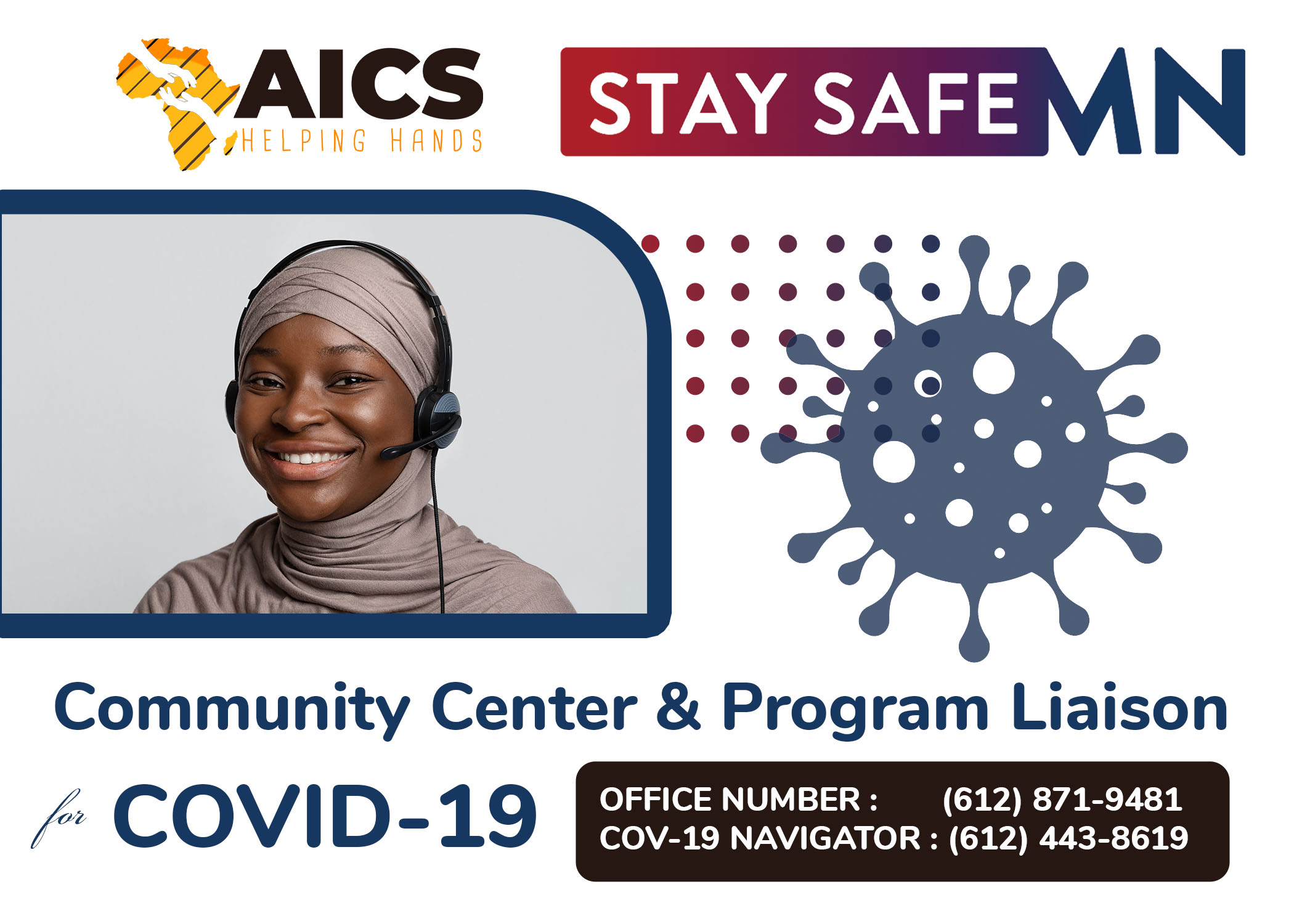African Immigrants Community Services is working with the MN Department of Health to increase access to Covid-19 testing and support for the Somali and East African refugee communities. It is critical that families have accurate information, can recognize the symptoms of Covid-19, and get tested as soon as they become ill or have been with someone who has tested positive for the virus. On this webpage you will find information about symptoms, precautions you can take to protect yourself and your family from infection, who should get tested, what to do if you test positive for the virus, and resources available to families with ill family members.

COVID-19 Updates
COVID-19 Testing
COVID-19 Vaccination
COVID-19 in Somali
CALL US: (612) 871-948
AICS has Covid-19 Specialists who will answer your questions, refer you to resources both within the agency and to other community resources, and will help you navigate those resources to make sure your needs do not fall between the cracks.
First, let’s take a look at the frequently asked questions regarding Covid-19.
COVID-19 is thought to spread mainly from person to person through respiratory droplets produced when an infected person coughs, sneezes, or exhales. These droplets can land in the mouths or noses of people who are nearby (within about 6 feet) or possibly be inhaled into the lungs. Some people without symptoms may be able to spread the virus. Public health experts are still learning about how the virus spreads and the severity of illness it causes.
More information can be found on CDC: How COVID-19 Spreads.
Students, faculty, and staff can help do their part to reduce the spread of COVID-19 by practicing social distancing (staying 6 feet from others), wearing face coverings, and washing their hands often. All measures should be used together; for example, wearing a face covering does not mean social distancing is not necessary.
Symptoms of COVID-19 can include fever, cough, difficulty breathing, new loss of taste or smell, sore throat, chills, new severe headache, muscle pain, sore throat, nausea, vomiting, diarrhea, excessive fatigue, and nasal congestion or runny nose.
Not everyone with COVID-19 has all these symptoms. Some may have very mild symptoms and some people may not have any.
Symptoms may appear from two to 14 days after being exposed to the virus (SARS-CoV-2) that causes COVID-19.
You can monitor yourself for symptoms of COVID-19 using the tool or symptom checker provided by your college or university, if available. Symptom checkers are also available at:
Stay home if you are sick or have symptoms. Call your health care provider, if needed.
The virus that causes COVID-19 can affect people in different ways. Most people have mild or moderate symptoms, and many get better without seeking medical care. However, some people require hospitalization, including intensive care, and the infection can sometimes be fatal.
The virus may also lead to long-term health problems, particularly for those who develop severe illness. For instance, the disease may cause damage to the lungs, leading to ongoing trouble with breathing.
Some people are at higher risk for complications from COVID-19. For example:
- Older adults are at higher risk for severe illness.
- People of any age who have certain underlying medical conditions may have a greater risk of getting seriously ill from COVID-19.
See CDC: People at Increased Risk for guidance for people who are at increased risk and should be extra careful to avoid contracting COVID-19.
For more information, see Managing Chronic Conditions during COVID-19.
If you develop symptoms while at work, notify your supervisor or appropriate staff and leave immediately.
Resources for what to do when you are sick:
- Avoid gathering in groups in social settings, including in bars, break rooms, and common areas.
- Make sure you are at least 6 feet from other people who are not members of your household at all times, even when wearing a mask.
In general, it means being within 6 feet of someone who has COVID-19 for 15 minutes or more.
You may choose to remind the group that for everyone’s safety, they should move 6 feet apart. Be kind and considerate, not confrontational.
Avoid groups that are not following social distancing guidelines, and if on campus, consider reporting to your COVID-19 point-person or team.
As of July 25, 2020, per the Governor’s Emergency Executive Order 20-81 (PDF), people in Minnesota are required to wear a face covering (often called a mask) in all indoor businesses and public indoor spaces, unless an exemption applies. The Executive Order also outlines several situations where people are permitted to remove their face covering temporarily (such as when eating or drinking, or when alone in a room or private vehicle).
Face coverings, including masks, can help stop your germs from infecting others. They may also offer some protection for the wearer.
Follow your college or university’s additional requirements about face coverings while you are on campus.
Cover your nose and mouth with a face covering and try to fit it snugly against the sides of your face.
Try not to touch the front of your face covering. Keep the mask on your face the whole time you are out. Don’t put the mask around your neck or on your forehead.
If you are using a face covering made of cloth or some other reusable material, wash your face covering after each time you wear it. Cloth coverings can be machine or hand washed, and should be dried completely prior to use.
Learn more at How to Safely Wear Your Mask (PDF).
